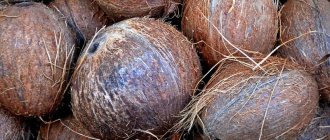How to crack a coconut at home
There are different ways to open a coconut at home. The method of opening depends on the purpose (to obtain whole halves of the peel, to preserve the pulp), physical capabilities, and the tools at hand.
What you need to open a nut
In countries where coconut palms grow, they use a special device. This is a two-in-one device: a corkscrew and a drill. If you're lucky, tourists buy it. Residents of other regions can use home remedies to open the fruit:
- A knife of solid dimensions.
- A hatchet for chopping meat.
- Awl, screwdriver, nail, drill.
- Hammer.
- Spoon, utensil for liquid made from coconut.
- Plastic bag or cling film.
- A stable stand (preferably a wooden cutting board).
Every home has two or three tools from this list.
How to crack a coconut with a knife
To work at home, you will need a knife with a strong blade and handle. It is easiest to open a drupe (as a coconut is scientifically called) with a knife along the edge. It runs down the middle of the fruit and stands out visually.
Procedure:
- Take the coconut in one hand, the knife in the other (working) hand.
- While turning the fruit along its axis, tap firmly on the rib with the blunt side of the knife.
- Carefully (!) insert a knife blade into the hole.
- Pull the shells apart a little to pour the juice into the container.
- The fruit is finally cut with a knife.
- If the conditions are met, the shell will split into halves.
Be careful: the crack that appears during the split may pinch your fingers.
Using holes
Three darkish spots are visible on one of the “poles” of the fruit. The easiest way to open a drupe through them is:
- You need to choose the softest one.
- Place the coconut on the table with a towel on it (to prevent it from slipping).
- Place a nail, awl or screwdriver on the selected fragment and lightly hit it with a hammer.
- Drain the water through the resulting hole into a container.
When the hole is ready, there will be a popping sound, similar to when opening a bottle of beer or soda.
- If the holes are small, use a drill to drill another one on the opposite side of the coconut. The juice will flow out faster.
Next, open the shell. A knife is inserted into the hole and the handle is hit with something heavy. When the blade plunges deep, it is turned to fully reveal the exotic.
With a hammer
Alternatively, you can cut a coconut at home with a hammer and screwdriver:
- A hole is made in the place of two spots so that the liquid flows out faster. To do this, place a screwdriver against the recess and hit it with a hammer.
- After draining the liquid, the drupe is wrapped in polyethylene or film, laid on a hard surface, and hit on the seam with a hammer.
- The thin end of a hammer or knife is inserted into the resulting crack. Turn with pressure, passing around the circle.
You can also open it by inserting a screwdriver into the crack, then driving it deeper and hitting it with a hammer.
Heat in the oven
The safest, force-free way to open a coconut at home is by heat treatment.
The liquid is poured out of the coconut, placed in a mold, and placed in the oven (175-185°C) or microwave (full power) for 15-20 minutes. If the conditions are met, the shell will burst and the pulp will easily come away from it.
Open with a saw and screwdriver
The fruit is placed on a hard surface and sawed along the central seam. When a crack appears, insert a screwdriver there. Press firmly down and to the sides. You should open a coconut this way when you need even halves.
Open manually
If you don’t have the necessary tools at home, you can open the drupe manually:
- The coconut is hit hard against stone, concrete, or other hard surface. Hold it so that the convex seam is exposed to impact.
- You can hit the seam of the coconut with a stone.
Before cracking a coconut outside the house, it is wrapped in polyethylene or cloth to prevent dirt from getting inside.
The main condition is the correct impact force. If it is very strong, the drupe will split and the juice will flow out. With a weak impact, it will not be possible to break the coconuts immediately.
Extracting juice and pulp
There are different ways to get the pulp out of the shell at home. But first, liquid is removed through the holes.
How to cut a coconut at home is determined by the purpose and the required “entourage”:
- Just enjoy. Remove the core from the parts of the split fruit with a spoon and eat.
- Cut out the pulp as a source for dishes with a sharp knife. The blade of the knife is inserted between the peel and the pulp and slowly turned to separate the pieces. A spoon will do instead of a knife, but the process will slow down.
- For aesthetes. Slice the flesh directly onto the coconut skin, then remove it into nice pieces one at a time.
You can clean a coconut at home in one of three ways:
- Place the “dehydrated” fruit in a container, place it in the microwave for 15 minutes (set to maximum) or in the oven for 18-20 minutes at 185-195°C.
- Place in the freezer for 15-25 minutes.
- Combined method. Oven, then freezer (15-18 minutes each).
Under such conditions (heat, cold, temperature changes), the shell will crack. If you then lightly tap the fruit, it will easily peel off the shell.
Heat or temperature changes will rupture the nut if the liquid is not removed first. Therefore, coconuts without juice are sent to the oven or freezer.
A thin brown layer of skin remains on the kernel. At home, it is removed with a knife, vegetable or potato peeler.
Coconut milk
One hundred grams of coconut milk contains enough fats and proteins, the energy value is 395 kcal. Milk can slow down the process of skin aging. The juice is also good for digestion.
Also, the juice of this fruit is actively used in cosmetology, adding it to lotions and shampoos. It disinfects, soothes, tones and moisturizes the skin. There is even one legend according to which the Queen of Sheba performed ablutions exclusively with coconut milk, adding goat milk to it. Thus, she remained young and beautiful for a long time.
Milk is also indispensable for treating various rashes that may appear due to allergies.
How to open a green drinking coconut
The drinking fruit is a young green coconut filled with coconut water. The hardness of the peel is comparable to pumpkin. Drinking coconut is easy to open at home:
- Make a hole with a “coconut” corkscrew or drill.
- Cut off the top with a knife.
Pour the water into a glass or drink through a straw.
The most popular home method for opening a drinking coconut of medium ripeness is to make four cuts with a cleaver, then remove the “lid”. A prerequisite is to be careful not to injure your hands.
This is a dietary product. Coconut juice has a calorie content of no more than 25 units per 100 g (milk has six times more calories).
Coconut water (or juice) is the liquid inside the drupe. Coconut milk is a product of processing the pulp of the fruit.
What to do with coconut meat
The snow-white “filling” at home becomes an exotic variation of milk or butter.
Milk
The manufacturing process is simple:
- The pulp is crushed - with a blender or on a grater.
- Dilute the mixture with boiled warm water.
The proportion is chosen as desired (half with water, a third or another). The less water, the fattier the milk will be.
- Beat the mixture with a blender and strain through a sieve or cheesecloth. You can strain immediately (especially in hot weather) or leave for 25-30 minutes, then strain.
The result is ready-to-drink coconut milk. When making a house, the proportion with water is important:
- If milk will be an ingredient in baking, use one part of the mixture to two parts of water.
- The oil liquid is diluted minimally (no more than 1:1).
- For a drink or smoothie, an arbitrary proportion is selected. The smoothie is prepared as with regular milk: milk, berries or fruits are whipped with a blender.
It is better to drink the milk immediately before the beneficial properties are lost. Or put it in the refrigerator, freeze it in molds.
Oil
Coconut oil is prepared at home in two ways:
- Place the cooled coconut milk in the refrigerator for a day. When it separates, remove the top layer (like cream from cow's milk). Transfer to a container.
- More complicated way. Grind the pulp and add warm water. When cool, place in the refrigerator for a day. During this time (or faster), a layer of coconut oil will form - the consistency of lard. Remove it and collect it in a fireproof container. Melt in a gentle water bath until just liquid. Strain through a sieve or cheesecloth to separate the shavings.
Ripe, “old” fruits are suitable. They produce the largest amount of the fattest oil.
The oil can be stored refrigerated for a maximum of a week.
Shavings
Coconut pulp is stored at home in the form of shavings. It is grated and lightly squeezed. Next, choose one of the methods:
- The surface is covered with paper without printing ink. Distribute the chips in a thin layer and leave to dry naturally.
- Line a baking sheet with parchment or craft paper and spread the chips in a thin layer. Place in an oven preheated to 50-60°C with the door closed. Under such conditions, the shavings dry out in one and a half to two days.
- A faster way. The chips are dried in the oven (95-100°C) with the door open.
At home, copra (the so-called dried coconut pulp) is stored in paper bags, glass containers or frozen.
Coconut shell
Coconut shells are turned into home decor:
- salt shaker;
- a bowl for a decorative candle;
- “box” for small items that always disappear somewhere;
- pots for home flowers;
- toy for a child.
A prerequisite is cleanliness. The material is thoroughly cleaned of remaining pulp, washed and dried. Small shards will be used for drainage of home or garden flowers.
We won't throw away the shells
If cutting a coconut was so impressive that you wanted to keep these exciting moments in your memory, make a souvenir from the shell. Most often, halves of nuts are used as a salt shaker, candlestick, plate for buttons, keys and other small items. If the shell is quite deep, then by turning it upside down, you will get an excellent eco-house for a hamster. Small and unsightly shards will serve as drainage for indoor flowers.
Photo gallery: decorative and household items made from coconut shells
Candlesticks made from coconut halves will decorate any occasion
Coconut shell feeder is very environmentally friendly
Box in the shape of an egg - almost Faberge
Cacti in a coconut pot feel like home
Precautionary measures
The coconut shell is hard; opening the fruit at home is difficult, especially at first, when the skill has not been developed. When deciding to break coconuts at home, follow these rules:
- When using a hammer, chisel, or saw, take care of your fingers.
- If you plan to hit the drupe with a hammer until it splits, wrap the fruit. A thick plastic bag or several layers of cling film will do.
- Do not try to open the coconut with the sharp side of the knife blade; the tool will slip or break.
- When piercing the “eyes” of the nut, fix the fruit or ask to hold it.
- When cutting a coconut on the table, place a cloth to prevent it from slipping.
- Wear goggles to protect your eyes.
- Remove children, especially young ones, from the premises.
Compliance with safety precautions is mandatory: sharp objects are used when cutting coconuts. Shell fragments can get into the face, eyes, and injure other parts of the body.
The main condition is not to rush, to be attentive and focused. After several procedures the skill will appear.
Storage
Eat walnuts immediately after opening; they don't last long. The endosperm deteriorates especially quickly.
How to store the pulp: wrap in cling film and refrigerate. There it can lie for up to a month.
The coconut that looks like a monkey is worth opening. Imagine what variety will be on your menu and what benefits your body will receive.
I hope my instructions on how to open a coconut will help you. And I will continue to tell you about different healthy nuts.
How to Store an Open Coconut
If a sour smell emanates from an opened drupe, it is thrown away. To avoid such trouble, choose the right coconut. It meets four conditions:
- Heavy, “gurgling” (that is, with juice inside).
- The peel is light and whole.
- The fibers are not too wrinkled.
- The three indentations on the crown are intact, clean, elastic, and without signs of mold.
It is better to drink the juice right away. A coconut that has been opened but not removed from the shell can be stored in a home refrigerator for 3-5 days. The shelf life of the pulp depends on the method of processing and storage. Copra - up to a year, frozen - six months, fresh - two days on the refrigerator shelf.
Conclusion. Personally, opening a coconut at home is not an easy task, especially during your first attempts.
But there is always a tool and a way in the house to cope with the task. Enjoying tropical exotics is worth it.
How is it useful?
The benefits of coconut for the body are quite extensive. It contains the following beneficial microelements:
- vitamins B, E and C;
- mineral salts;
- sucrose;
- fructose.
Thanks to such a rich and healing composition, the nut helps improve vision, promotes restoration of strength, and also has healing properties. It is not for nothing that Asians have always considered the fruit a vital elixir, which not only nourishes the human body, but also helps restore water balance.











